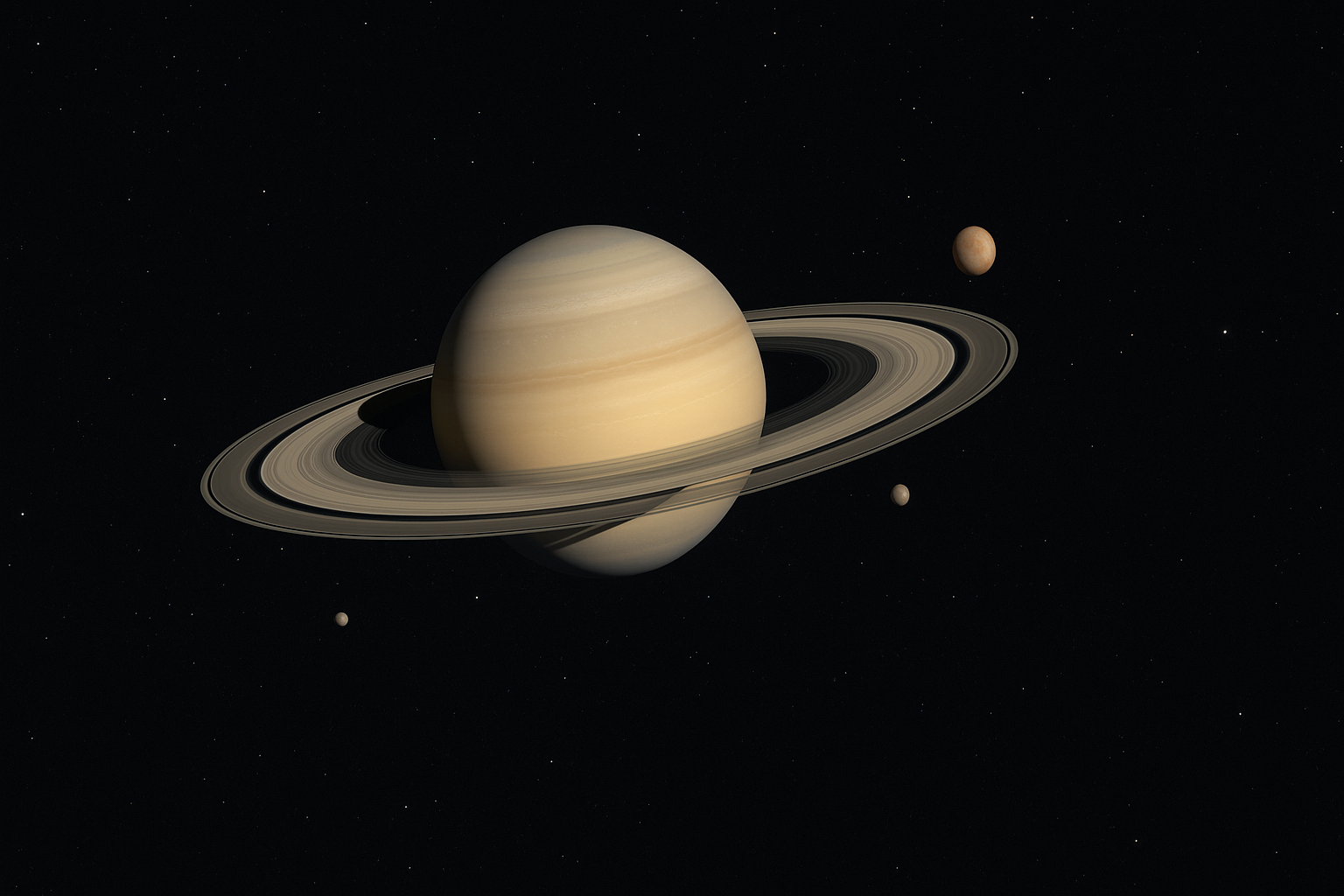Link to TikTok:
🎥 Watch the short video version on TikTok →
Saturn just broke the solar system’s record. With 20 new moons discovered, its total count now exceeds 140—more than any other planet. But this isn’t just a numerical victory. Some of these moons orbit backwards. Others are irregular, chaotic fragments, likely born in ancient collisions. Each tiny world tells a story not just of Saturn, but of the chaotic past that shaped our solar system.
This isn’t just astronomy.
It’s cosmic archaeology.
The Moon Race: Saturn vs. Jupiter
 For years, Jupiter held the crown for most known moons. But with advanced surveys like the Subaru Telescope’s Outer Planet Moon Search, Saturn has reclaimed the throne. As of 2024, Saturn is confirmed to host 145 moons—ranging from giants like Titan to kilometer-wide rocklets on the planet’s fringes.
For years, Jupiter held the crown for most known moons. But with advanced surveys like the Subaru Telescope’s Outer Planet Moon Search, Saturn has reclaimed the throne. As of 2024, Saturn is confirmed to host 145 moons—ranging from giants like Titan to kilometer-wide rocklets on the planet’s fringes.
These aren’t just rocks in orbit. They’re records of impacts, capture events, and gravitational battles going back 4.5 billion years.
Not Your Average Moon
Many of Saturn’s new satellites are classified as irregular moons. What does that mean?
- Highly elliptical orbits: They don’t circle neatly like Earth’s moon.
- Inclined paths: Some tilt dramatically, moving at odd angles to Saturn’s equator.
- Retrograde motion: Over half move backwards—opposite the planet’s rotation.
▶ That’s not an error—it’s a clue.
These moons weren’t born with Saturn. They were captured, possibly after violent encounters with asteroids, comets, or other moons.
Fragmented Histories: Crashes That Made Moons
Saturn’s outer system may be the aftermath of ancient demolition.
The orbits of many moons cluster into families—groups with similar inclinations and distances. This suggests they originated from larger bodies that shattered, likely in cataclysmic collisions.
Take the Norse group—a set of retrograde moons with similar orbits. They likely came from a parent moon that broke apart, spreading fragments across Saturn’s orbital space like cosmic shrapnel.
Each one is a fossil, not of biology—but of celestial violence.
Why So Many? The Role of Saturn’s Gravity
Saturn is lighter than Jupiter but has a wider and more complex gravitational reach thanks to:
- Its enormous ring system
- A larger Hill sphere (the region where its gravity dominates)
- Proximity to the outer solar system’s debris fields
This makes Saturn a moonsweeper—a planet more likely to snag and hold onto wandering objects.
Jupiter, by contrast, clears space more aggressively, ejecting unstable moons instead of collecting them.
Tiny Moons, Big Science
Why care about rocks a few kilometers wide?
Because each one acts like a time capsule. Their shape, orbit, and composition can reveal:
- How planets capture objects
- What materials were flying around in the early solar system
- Whether other systems beyond ours might host similar moon swarms
Studying these moons gives insight into how solar systems evolve—and how rare (or common) our planetary architecture may be.
The Titan Exception: A Moon Like a Planet
Among Saturn’s many moons, Titan stands apart. It’s larger than Mercury and hosts rivers, lakes, and rain—of liquid methane.
NASA’s upcoming Dragonfly mission (launching in 2027) will land a nuclear-powered drone on Titan, exploring its chemistry and prebiotic potential. Compared to the tiny, irregular satellites, Titan feels like a whole different class of moon—suggesting that Saturn’s system is not just vast, but wildly diverse.
Saturn’s Moons and the Origins of Chaos
The solar system wasn’t born stable. It was forged in fire, ice, and impact.
- Moons collided and reformed.
- Asteroids were captured and flung away.
- Gravitational tug-of-wars shaped who stayed and who didn’t.
Saturn’s moon swarm is the evidence. It’s a record of the chaotic adolescence of our planetary system—one we’re still piecing together.
And with each new moon, the picture sharpens.
TL;DR
- Saturn now hosts over 145 moons, surpassing Jupiter.
- Many are irregular, retrograde, and fragmented—suggesting violent origins.
- These moons act as archaeological records of solar system history.
- Studying them helps us understand planet formation, moon capture, and cosmic evolution.
- Saturn isn’t just a ringed planet—it’s a museum of early solar system chaos.
References
- Sheppard, S. S. (2023). “Irregular Satellites of the Outer Planets.” Annual Review of Astronomy and Astrophysics.
- Jewitt, D., & Haghighipour, N. (2007). “Irregular Satellites of the Planets: Products of Capture in the Early Solar System.” Annual Review of Astronomy and Astrophysics.
- NASA Planetary Fact Sheets – Saturn’s Moons: https://solarsystem.nasa.gov/moons/saturn-moons/overview/
- Carnegie Science – Moon Discoveries by Scott Sheppard: https://carnegiescience.edu/scientist/scott-sheppard
- TikTok video reference: @nerdicate on TikTok
Discussion
Are these tiny moons the debris of ancient worlds—or just the beginning of a deeper cosmic story we’ve barely started to read?
